Variations of Urban Thermal Risk with Local Climate Zones
Abstract
1. Introduction
2. Materials and Methods
2.1. Study Area
2.2. Data
2.3. Methods
2.3.1. LCZ Classification
2.3.2. Calculation of Heat Risk Index
Heat Hazard Index
Heat Vulnerability Index
Heat Exposure Index
3. Results
3.1. LCZ Classification
3.2. Heat Risk Index
4. Discussion
5. Conclusions
Author Contributions
Funding
Institutional Review Board Statement
Informed Consent Statement
Data Availability Statement
Acknowledgments
Conflicts of Interest
References
- Shi, W.; Hou, J.; Shen, X.; Xiang, R. Exploring the Spatio-Temporal Characteristics of Urban Thermal Environment during Hot Summer Days: A Case Study of Wuhan, China. Remote Sens. 2022, 14, 6084. [Google Scholar] [CrossRef]
- Henao, J.J.; Rendon, A.M.; Salazar, J.F. Trade-off between Urban Heat Island Mitigation and Air Quality in Urban Valleys. Urban Clim. 2020, 31, 100542. [Google Scholar] [CrossRef]
- Yang, R.; Yang, J.; Wang, L.; Xiao, X.; Xia, J. Contribution of Local Climate Zones to the Thermal Environment and Energy Demand. Front. Public Health 2022, 10, 992050. [Google Scholar] [CrossRef]
- Yang, J.; Luo, X.; Jin, C.; Xiao, X. Spatiotemporal Patterns of Vegetation Phenology along the Urban-Rural Gradient in Coastal Dalian, China. Urban For. Urban Green. 2020, 54, 126784. [Google Scholar] [CrossRef]
- Aghamohammadi, N.; Fong, C.S.; Idrus, M.H.M.; Ramakreshnan, L.; Sulaiman, N.M. Environmental Heat-Related Health Symptoms among Community in a Tropical City. Sci. Total Environ. 2021, 782, 146611. [Google Scholar] [CrossRef]
- He, B.-J. Potentials of Meteorological Characteristics and Synoptic Conditions to Mitigate Urban Heat Island Effects. Urban Clim. 2018, 24, 26–33. [Google Scholar] [CrossRef]
- Ward, K.; Lauf, S.; Kleinschmit, B.; Endlicher, W. Heat Waves and Urban Heat Islands in Europe: A Review of Relevant Drivers. Sci. Total Environ. 2016, 569, 527–539. [Google Scholar] [CrossRef] [PubMed]
- Zhao, C.; Liu, B.; Piao, S.; Wang, X.; Lobell, D.B.; Huang, Y.; Huang, M.; Yao, Y.; Bassu, S.; Ciais, P.; et al. Temperature Increase Reduces Global Yields of Major Crops in Four Independent Estimates. Proc. Natl. Acad. Sci. USA 2017, 114, 9326–9331. [Google Scholar] [CrossRef]
- Milan, B.F.; Creutzig, F. Reducing Urban Heat Wave Risk in the 21st Century. Curr. Opin. Environ. Sustain. 2015, 14, 221–231. [Google Scholar] [CrossRef]
- Tan, K.; Qin, Y.; Du, T.; Li, L.; Zhang, L.; Wang, J. Biochar from Waste Biomass as Hygroscopic Filler for Pervious Concrete to Improve Evaporative Cooling Performance. Constr. Build. Mater. 2021, 287, 123078. [Google Scholar] [CrossRef]
- Zhang, G.; He, B.-J. Towards Green Roof Implementation: Drivers, Motivations, Barriers and Recommendations. Urban For. Urban Green. 2021, 58, 126992. [Google Scholar] [CrossRef]
- Stewart, I.D.; Oke, T.R. Local Climate Zones for Urban Temperature Studies. Bull. Amer. Meteorol. Soc. 2012, 93, 1879–1900. [Google Scholar] [CrossRef]
- Chakraborty, T.; Lee, X. A Simplified Urban-Extent Algorithm to Characterize Surface Urban Heat Islands on a Global Scale and Examine Vegetation Control on Their Spatiotemporal Variability. Int. J. Appl. Earth Obs. Geoinf. 2019, 74, 269–280. [Google Scholar] [CrossRef]
- Varquez, A.C.G.; Kanda, M. Global Urban Climatology: A Meta-Analysis of Air Temperature Trends (1960–2009). npj Clim. Atmos. Sci. 2018, 1, 32. [Google Scholar] [CrossRef]
- Li, N.; Wang, B.; Yao, Y.; Chen, L.; Zhang, Z. Thermal Contribution of the Local Climate Zone and Its Spatial Distribution Effect on Land Surface Temperature in Different Macroclimate Cities. Remote Sens. 2022, 14, 4029. [Google Scholar] [CrossRef]
- Demuzere, M.; Kittner, J.; Bechtel, B. LCZ Generator: A Web Application to Create Local Climate Zone Maps. Front. Environ. Sci. 2021, 9, 637455. [Google Scholar] [CrossRef]
- Yang, J.; Ren, J.; Sun, D.; Xiao, X.; Xia (Cecilia), J.; Jin, C.; Li, X. Understanding Land Surface Temperature Impact Factors Based on Local Climate Zones. Sustain. Cities Soc. 2021, 69, 102818. [Google Scholar] [CrossRef]
- Shi, Z.; Yang, J.; Zhang, Y.; Xiao, X.; Xia, J.C. Urban Ventilation Corridors and Spatiotemporal Divergence Patterns of Urban Heat Island Intensity: A Local Climate Zone Perspective. Environ. Sci. Pollut. Res. 2022, 29, 74394–74406. [Google Scholar] [CrossRef]
- Ren, J.; Yang, J.; Zhang, Y.; Xiao, X.; Li, X.; Wang, S.; Xia, J.C. Exploring Thermal Comfort of Urban Buildings Based on Local Climate Zones. J. Clean Prod. 2022, 340, 130744. [Google Scholar] [CrossRef]
- Du, H.; Wang, D.; Wang, Y.; Zhao, X.; Qin, F.; Jiang, H.; Cai, Y. Influences of Land Cover Types, Meteorological Conditions, Anthropogenic Heat and Urban Area on Surface Urban Heat Island in the Yangtze River Delta Urban Agglomeration. Sci. Total Environ. 2016, 571, 461–470. [Google Scholar] [CrossRef]
- Hou, H.; Su, H.; Liu, K.; Li, X.; Chen, S.; Wang, W.; Lin, J. Driving Forces of UHI Changes in China’s Major Cities from the Perspective of Land Surface Energy Balance. Sci. Total Environ. 2022, 829, 154710. [Google Scholar] [CrossRef]
- Yang, J.; Yang, Y.; Sun, D.; Jin, C.; Xiao, X. Influence of Urban Morphological Characteristics on Thermal Environment. Sustain. Cities Soc. 2021, 72, 103045. [Google Scholar] [CrossRef]
- Yang, J.; Zhan, Y.; Xiao, X.; Xia, J.C.; Sun, W.; Li, X. Investigating the Diversity of Land Surface Temperature Characteristics in Different Scale Cities Based on Local Climate Zones. Urban Clim. 2020, 34, 100700. [Google Scholar] [CrossRef]
- Aleksandrova, M.; Balasko, S.; Kaltenborn, M.; Malerba, D.; Mucke, P.; Neuschäfer, O.; Radtke, K.; Prütz, R.; Strupat, C.; Weller, D.; et al. Bündnis Entwicklung Hilft; WorldRiskReport 2021; Ruhr University Bochum—Institute for International Law of Peace and Armed Conflict (IFHV): Bochum, Germany, 2021. [Google Scholar]
- Johnson, D.P.; Stanforth, A.; Lulla, V.; Luber, G. Developing an Applied Extreme Heat Vulnerability Index Utilizing Socioeconomic and Environmental Data. Appl. Geogr. 2012, 35, 23–31. [Google Scholar] [CrossRef]
- Beckmann, S.K.; Hiete, M. Predictors Associated with Health-Related Heat Risk Perception of Urban Citizens in Germany. Int. J. Environ. Res. Public Health 2020, 17, 874. [Google Scholar] [CrossRef]
- Song, J.; Huang, B.; Kim, J.S.; Wen, J.; Li, R. Fine-Scale Mapping of an Evidence-Based Heat Health Risk Index for High-Density Cities: Hong Kong as a Case Study. Sci. Total Environ. 2020, 718, 137226. [Google Scholar] [CrossRef]
- Cheng, W.; Li, D.; Liu, Z.; Brown, R.D. Approaches for Identifying Heat-Vulnerable Populations and Locations: A Systematic Review. Sci. Total Environ. 2021, 799, 149417. [Google Scholar] [CrossRef]
- Li, L.; Zha, Y. Population Exposure to Extreme Heat in China: Frequency, Intensity, Duration and Temporal Trends. Sustain. Cities Soc. 2020, 60, 102282. [Google Scholar] [CrossRef]
- Yasumoto, S.; Jones, A.P.; Oyoshi, K.; Kanasugi, H.; Sekimoto, Y.; Shibasaki, R.; Comber, A.; Watanabe, C. Heat Exposure Assessment Based on Individual Daily Mobility Patterns in Dhaka, Bangladesh. Comput. Environ. Urban Syst. 2019, 77, 101367. [Google Scholar] [CrossRef]
- Nayak, S.G.; Shrestha, S.; Kinney, P.L.; Ross, Z.; Sheridan, S.C.; Pantea, C.I.; Hsu, W.H.; Muscatiello, N.; Hwang, S.A. Development of a Heat Vulnerability Index for New York State. Public Health 2018, 161, 127–137. [Google Scholar] [CrossRef]
- Azhar, G.; Saha, S.; Ganguly, P.; Mavalankar, D.; Madrigano, J. Heat Wave Vulnerability Mapping for India. Int. J. Environ. Res. Public Health 2017, 14, 357. [Google Scholar] [CrossRef] [PubMed]
- Bao, J.; Li, X.; Yu, C. The Construction and Validation of the Heat Vulnerability Index, a Review. Int. J. Environ. Res. Public Health 2015, 12, 7220–7234. [Google Scholar] [CrossRef]
- Zheng, M.; Zhang, J.; Shi, L.; Zhang, D.; Pangali Sharma, T.P.; Prodhan, F.A. Mapping Heat-Related Risks in Northern Jiangxi Province of China Based on Two Spatial Assessment Frameworks Approaches. Int. J. Environ. Res. Public Health 2020, 17, 6584. [Google Scholar] [CrossRef] [PubMed]
- Pramanik, S.; Punia, M.; Yu, H.; Chakraborty, S. Is Dense or Sprawl Growth More Prone to Heat-Related Health Risks? Spatial Regression-Based Study in Delhi, India. Sustain. Cities Soc. 2022, 81, 103808. [Google Scholar] [CrossRef]
- Ho, H.C.; Knudby, A.; Huang, W. A Spatial Framework to Map Heat Health Risks at Multiple Scales. Int. J. Environ. Res. Public Health 2015, 12, 16110–16123. [Google Scholar] [CrossRef]
- Howe, P.D.; Marlon, J.R.; Wang, X.; Leiserowitz, A. Public Perceptions of the Health Risks of Extreme Heat across US States, Counties, and Neighborhoods. Proc. Natl. Acad. Sci. USA 2019, 116, 6743–6748. [Google Scholar] [CrossRef]
- Dong, J.; Peng, J.; He, X.; Corcoran, J.; Qiu, S.; Wang, X. Heatwave-Induced Human Health Risk Assessment in Megacities Based on Heat Stress-Social Vulnerability-Human Exposure Framework. Landsc. Urban Plan. 2020, 203, 103907. [Google Scholar] [CrossRef]
- Dong, W.; Liu, Z.; Zhang, L.; Tang, Q.; Liao, H.; Li, X. Assessing Heat Health Risk for Sustainability in Beijing’s Urban Heat Island. Sustainability 2014, 6, 7334–7357. [Google Scholar] [CrossRef]
- Zhang, W.; Zheng, C.; Chen, F. Mapping Heat-Related Health Risks of Elderly Citizens in Mountainous Area: A Case Study of Chongqing, China. Sci. Total Environ. 2019, 663, 852–866. [Google Scholar] [CrossRef] [PubMed]
- Chen, Q.; Ding, M.; Yang, X.; Hu, K.; Qi, J. Spatially Explicit Assessment of Heat Health Risk by Using Multi-Sensor Remote Sensing Images and Socioeconomic Data in Yangtze River Delta, China. Int. J. Health Geogr. 2018, 17, 15. [Google Scholar] [CrossRef] [PubMed]
- Jiang, Y.; Fu, P.; Weng, Q. Downscaling GOES Land Surface Temperature for Assessing Heat Wave Health Risks. IEEE Geosci. Remote Sens. Lett. 2015, 12, 1605–1609. [Google Scholar] [CrossRef]
- Sobrino, J.A.; Oltra-Carrio, R.; Soria, G.; Bianchi, R.; Paganini, M. Impact of Spatial Resolution and Satellite Overpass Time on Evaluation of the Surface Urban Heat Island Effects. Remote Sens. Environ. 2012, 117, 50–56. [Google Scholar] [CrossRef]
- O’Sullivan, K.C.; Chisholm, E. Baby It’s Hot Outside: Balancing Health Risks and Energy Efficiency When Parenting during Extreme Heat Events. Energy Res. Soc. Sci. 2020, 66, 101480. [Google Scholar] [CrossRef]
- Bechtel, B.; Demuzere, M.; Mills, G.; Zhan, W.; Sismanidis, P.; Small, C.; Voogt, J. SUHI Analysis Using Local Climate Zones-A Comparison of 50 Cities. Urban Clim. 2019, 28, 100451. [Google Scholar] [CrossRef]
- Li, L.; Zhao, Z.; Wang, H.; Shen, L.; Liu, N.; He, B.-J. Variabilities of Land Surface Temperature and Frontal Area Index Based on Local Climate Zone. IEEE J. Sel. Top. Appl. Earth Observ. Remote Sens. 2022, 15, 2166–2174. [Google Scholar] [CrossRef]
- Yang, J.; Wang, Y.; Xiao, X.; Jin, C.; Xia (Cecilia), J.; Li, X. Spatial Differentiation of Urban Wind and Thermal Environment in Different Grid Sizes. Urban Clim. 2019, 28, 100458. [Google Scholar] [CrossRef]
- Guo, A.; Yang, J.; Xiao, X.; Xia (Cecilia), J.; Jin, C.; Li, X. Influences of Urban Spatial Form on Urban Heat Island Effects at the Community Level in China. Sustain. Cities Soc. 2020, 53, 101972. [Google Scholar] [CrossRef]
- Ebi, K.L.; Capon, A.; Berry, P.; Broderick, C.; de Dear, R.; Havenith, G.; Honda, Y.; Kovats, R.S.; Ma, W.; Malik, A.; et al. Hot Weather and Heat Extremes: Health Risks. Lancet 2021, 398, 698–708. [Google Scholar] [CrossRef]
- Gao, Y.; Chan, E.Y.Y.; Lam, H.C.Y.; Wang, A. Perception of Potential Health Risk of Climate Change and Utilization of Fans and Air Conditioners in a Representative Population of Hong Kong. Int. J. Disaster Risk Sci. 2020, 11, 105–118. [Google Scholar] [CrossRef]
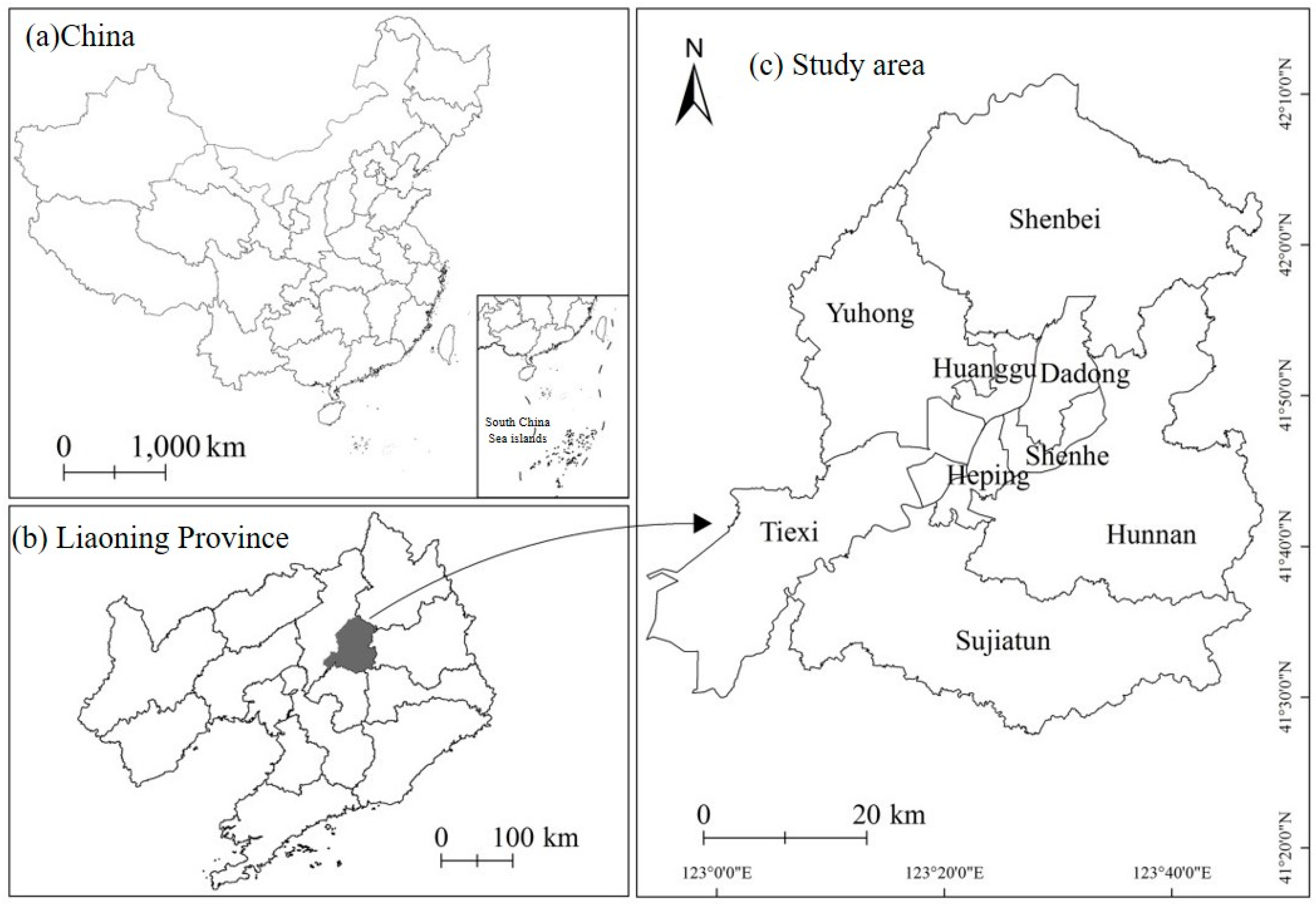
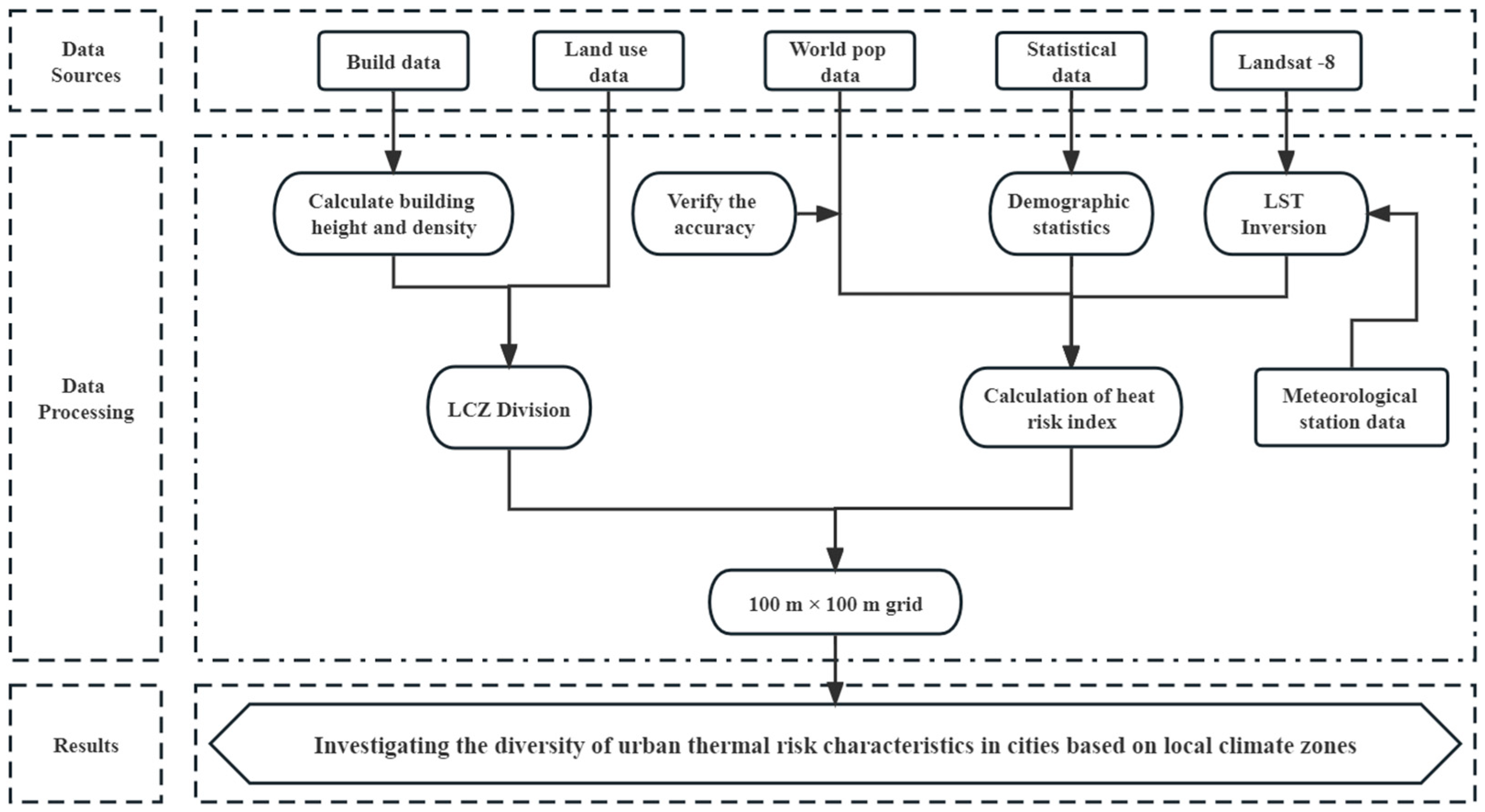
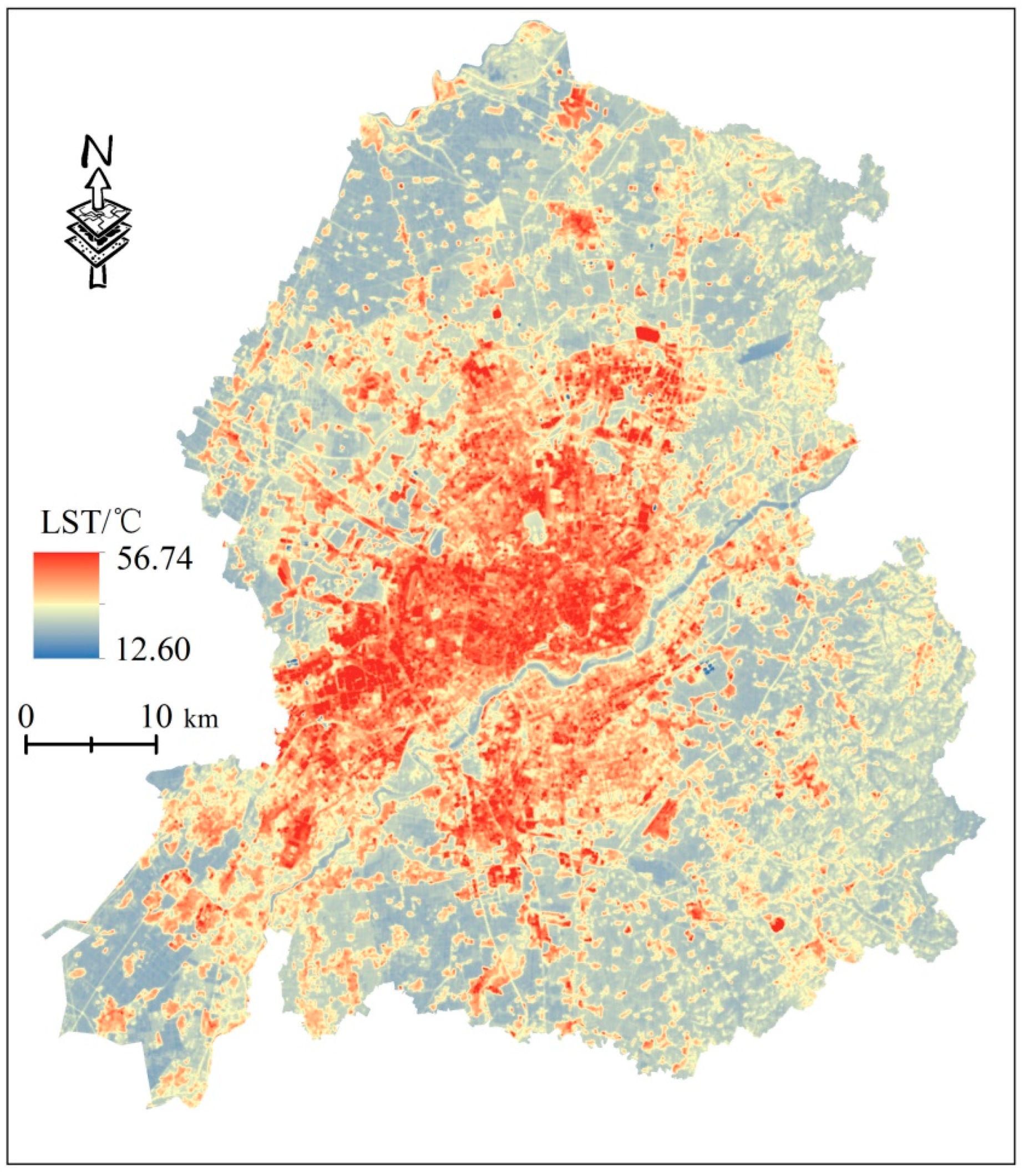

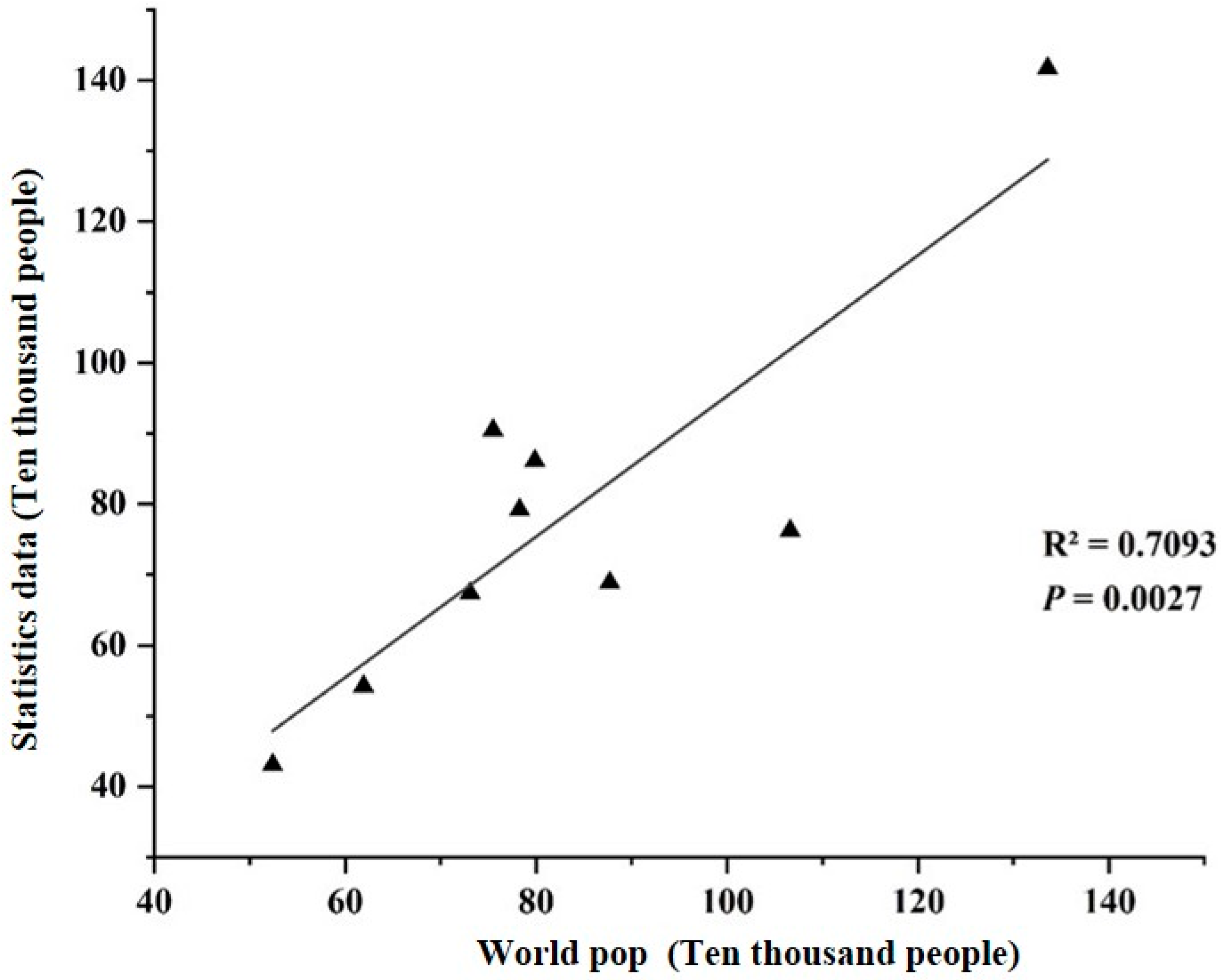
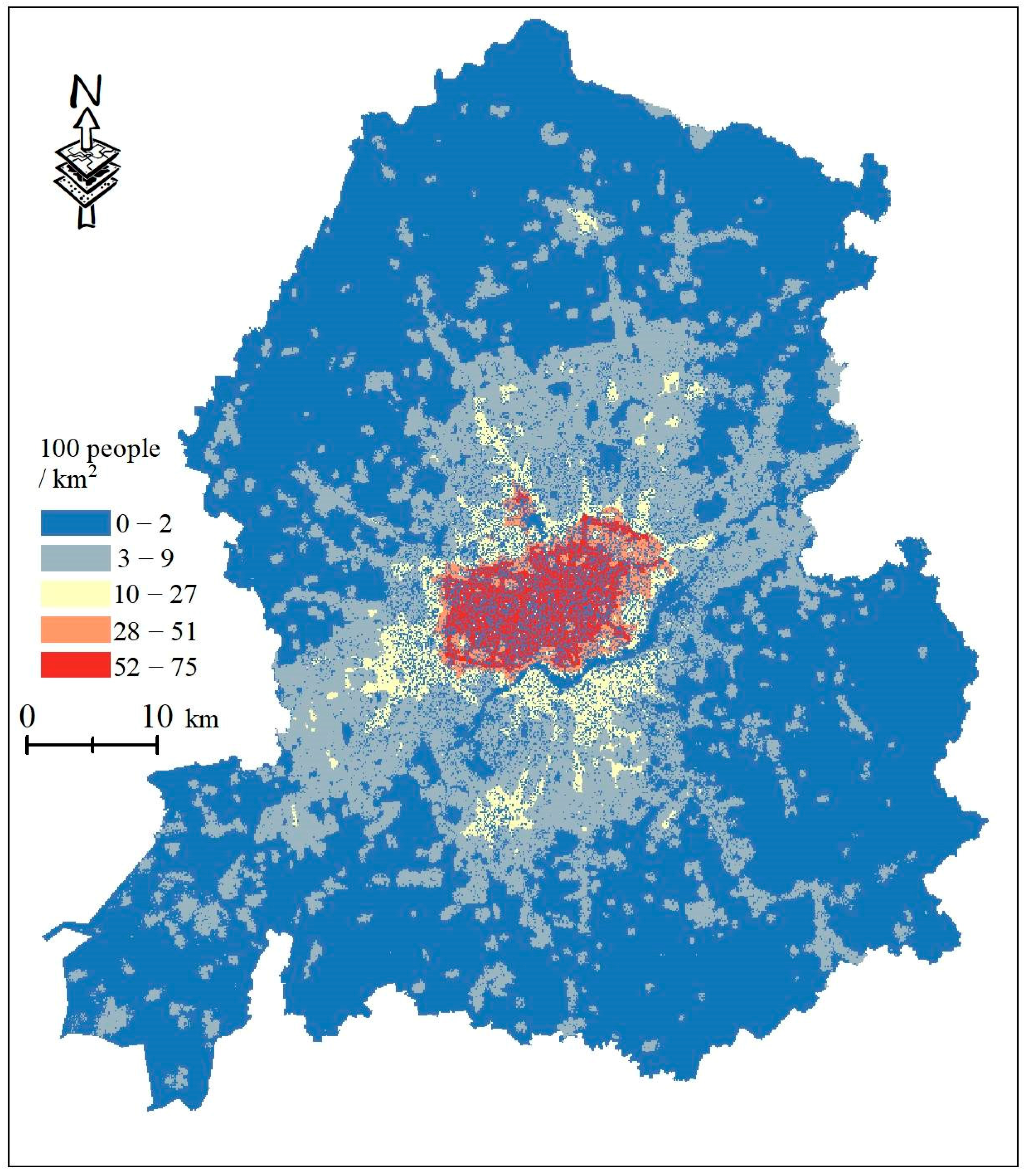
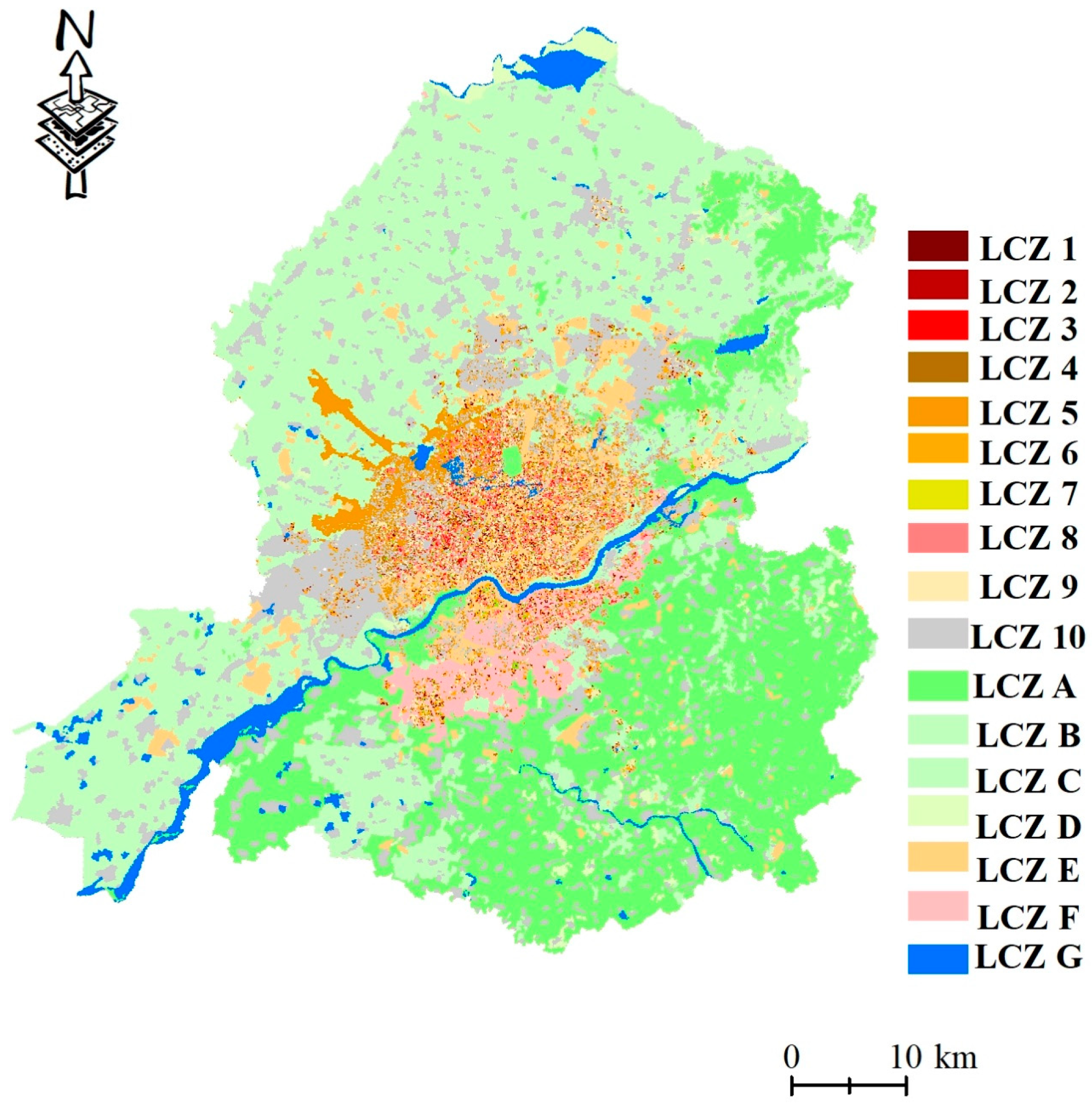
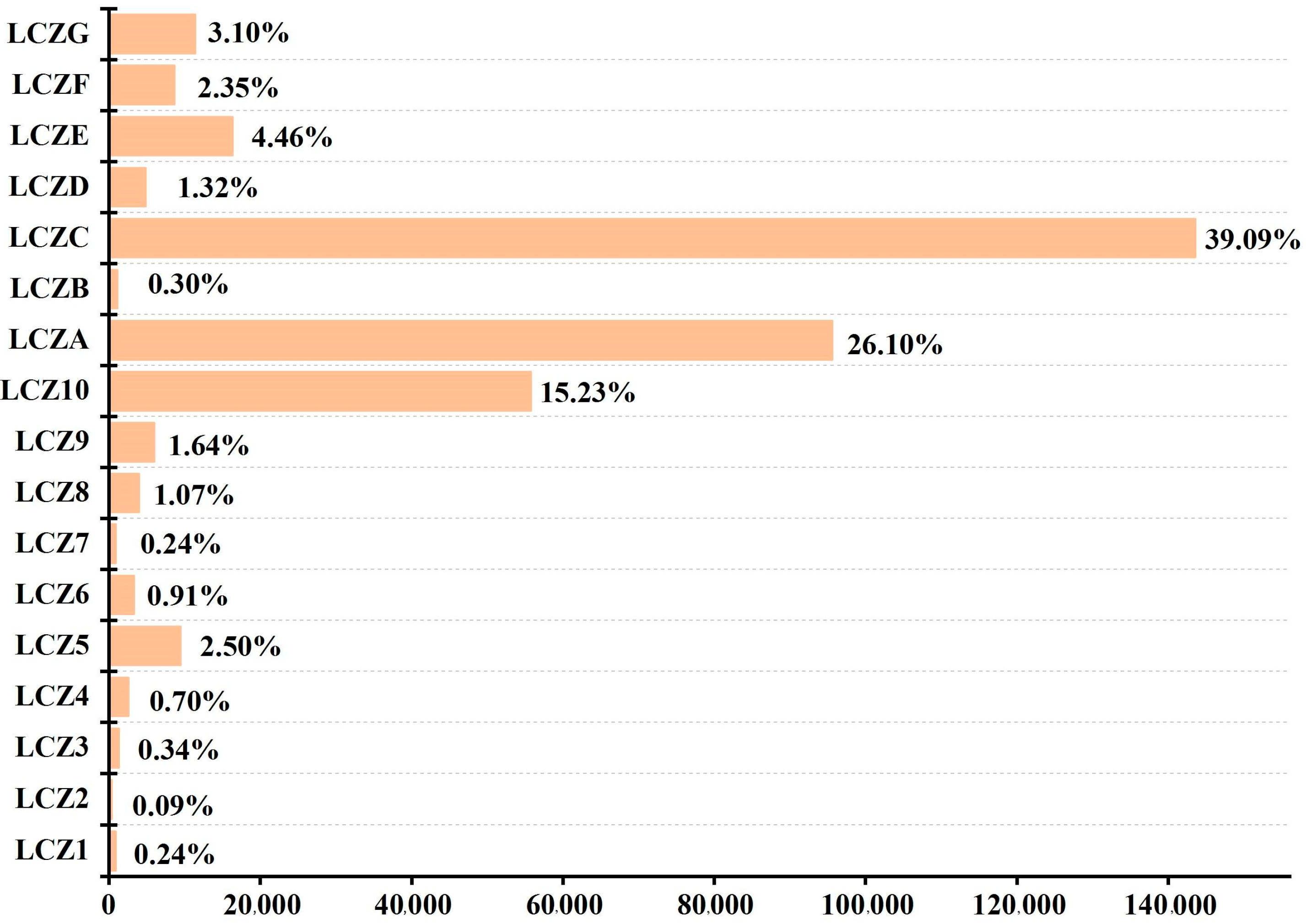
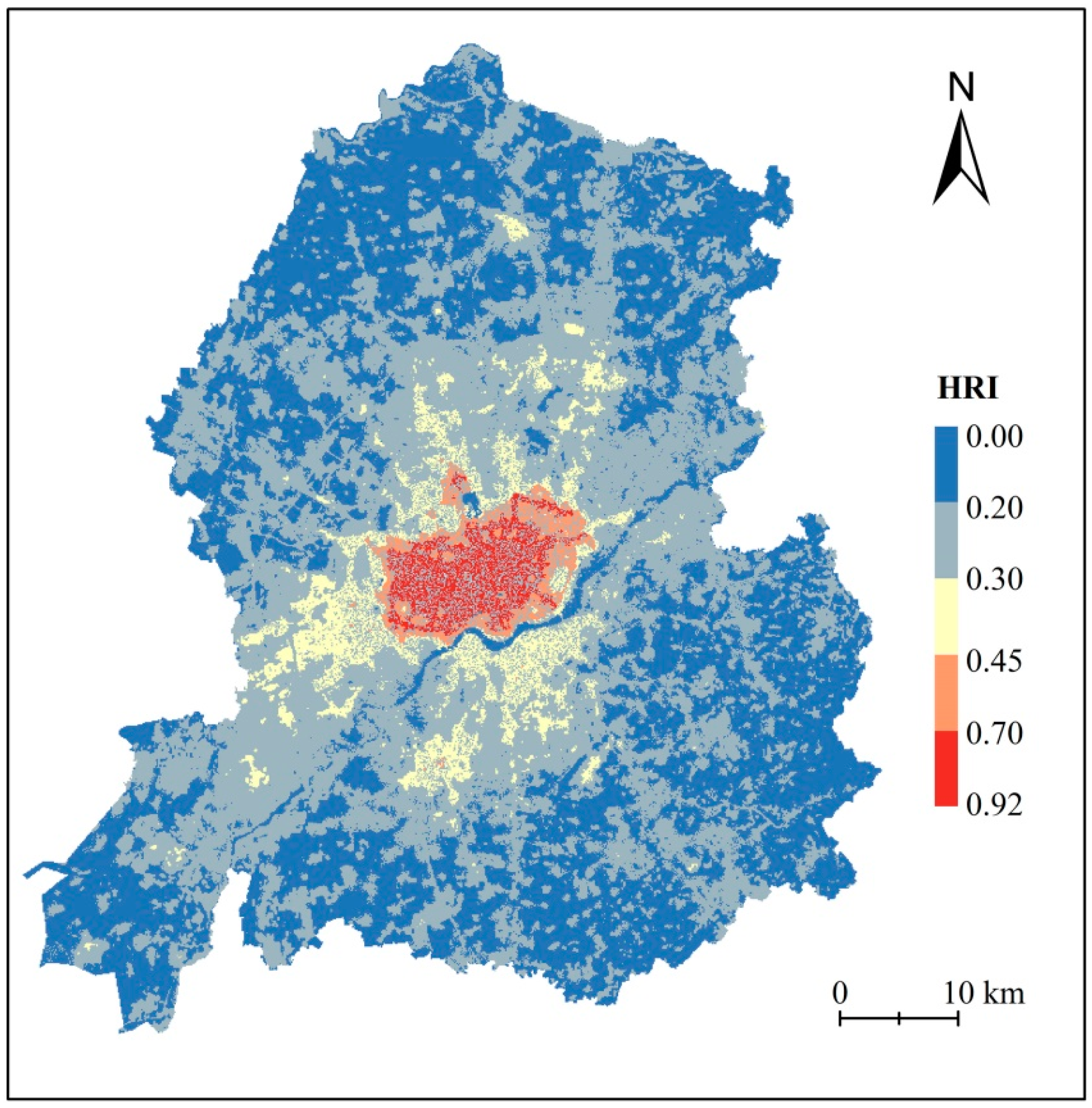

| Data Types | Time | Resolution | Sources |
|---|---|---|---|
| Landsat-8 | 2020.7.22 | 30 m | http://www.gscloud.cn/ (accessed date: 21 October 2022) |
| Build data | 2018 | - | https://map.baidu.com/ (accessed date: 21 October 2022) |
| Land use data | 2018 | 30 m | http://doi.org/10.5281/zenodo.4417809 (accessed date: 26 October 2022) |
| WorldPop data | 2020 | 100 m | https://www.worldpop.org/ (accessed date: 21 October 2022) |
| Socioeconomic and statistical data | 2020 | - | http://tjj.shenyang.gov.cn/ (accessed date: 24 October 2022) |
| Index | Calculate Formula | Description |
|---|---|---|
| Building density (BD) | represents the building base area in the unit grid, represents the grid area | |
| Building height (BH) | is the height of i buildings in the grid, N is the number of all buildings in the grid |
| Building LCZs | Explanation | Nature LCZs | Explanation |
|---|---|---|---|
| LCZ 1 | Compact super-high-rise (Above 12 floors) | LCZ A | Dense trees |
| LCZ 2 | Compact high-rise (10–12 floors) | LCZ B | Scattered trees |
| LCZ 3 | Compact middle-high-rise (7–9 floors) | LCZ C | Bush |
| LCZ 4 | Compact mid-rise (4–6 floors) | LCZ D | Grass |
| LCZ 5 | Compact low-rise (1–3 floors) | LCZ E | Bare rock and paved |
| LCZ 6 | Open super-high-rise (Above 12 floors) | LCZ F | Bare soil and sand |
| LCZ 7 | Open high-rise (10–12 floors) | LCZ G | Water |
| LCZ 8 | Open middle-high-rise (7–9 floors) | ||
| LCZ 9 | Open mid-rise (4–6 floors) | ||
| LCZ 10 | Open low-rise (1–3 floors) |
| LCZ Types | Min | Max | Avg | Std |
|---|---|---|---|---|
| LCZ 1 | 0.21 | 0.91 | 0.42 | 0.24 |
| LCZ 2 | 0.20 | 0.89 | 0.43 | 0.25 |
| LCZ 3 | 0.21 | 0.90 | 0.46 | 0.20 |
| LCZ 4 | 0.20 | 0.90 | 0.40 | 0.09 |
| LCZ 5 | 0.18 | 0.89 | 0.30 | 0.18 |
| LCZ 6 | 0.20 | 0.89 | 0.35 | 0.21 |
| LCZ 7 | 0.20 | 0.88 | 0.38 | 0.24 |
| LCZ 8 | 0.20 | 0.91 | 0.48 | 0.22 |
| LCZ 9 | 0.20 | 0.90 | 0.41 | 0.02 |
| LCZ 10 | 0.14 | 0.92 | 0.27 | 0.08 |
| LCZ A | 0.00 | 0.69 | 0.21 | 0.02 |
| LCZ B | 0.17 | 0.28 | 0.20 | 0.03 |
| LCZ C | 0.00 | 0.66 | 0.20 | 0.25 |
| LCZ D | 0.17 | 0.33 | 0.21 | 0.02 |
| LCZ E | 0.13 | 0.89 | 0.31 | 0.15 |
| LCZ F | 0.17 | 0.74 | 0.29 | 0.05 |
| LCZ G | 0.00 | 0.87 | 0.21 | 0.06 |
Disclaimer/Publisher’s Note: The statements, opinions and data contained in all publications are solely those of the individual author(s) and contributor(s) and not of MDPI and/or the editor(s). MDPI and/or the editor(s) disclaim responsibility for any injury to people or property resulting from any ideas, methods, instructions or products referred to in the content. |
© 2023 by the authors. Licensee MDPI, Basel, Switzerland. This article is an open access article distributed under the terms and conditions of the Creative Commons Attribution (CC BY) license (https://creativecommons.org/licenses/by/4.0/).
Share and Cite
Xin, J.; Yang, J.; Jiang, Y.; Shi, Z.; Jin, C.; Xiao, X.; Xia, J.; Yang, R. Variations of Urban Thermal Risk with Local Climate Zones. Int. J. Environ. Res. Public Health 2023, 20, 3283. https://doi.org/10.3390/ijerph20043283
Xin J, Yang J, Jiang Y, Shi Z, Jin C, Xiao X, Xia J, Yang R. Variations of Urban Thermal Risk with Local Climate Zones. International Journal of Environmental Research and Public Health. 2023; 20(4):3283. https://doi.org/10.3390/ijerph20043283
Chicago/Turabian StyleXin, Jiaxing, Jun Yang, Yipeng Jiang, Zhipeng Shi, Cui Jin, Xiangming Xiao, Jianhong (Cecilia) Xia, and Ruxin Yang. 2023. "Variations of Urban Thermal Risk with Local Climate Zones" International Journal of Environmental Research and Public Health 20, no. 4: 3283. https://doi.org/10.3390/ijerph20043283
APA StyleXin, J., Yang, J., Jiang, Y., Shi, Z., Jin, C., Xiao, X., Xia, J., & Yang, R. (2023). Variations of Urban Thermal Risk with Local Climate Zones. International Journal of Environmental Research and Public Health, 20(4), 3283. https://doi.org/10.3390/ijerph20043283








